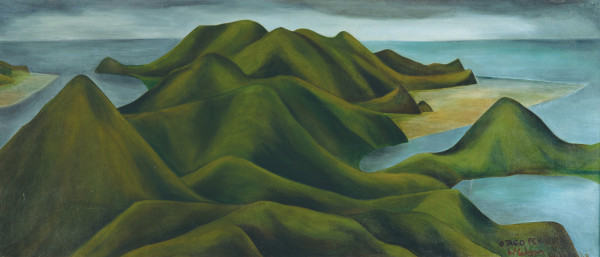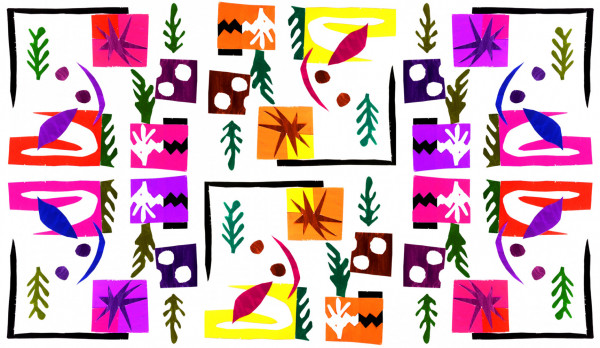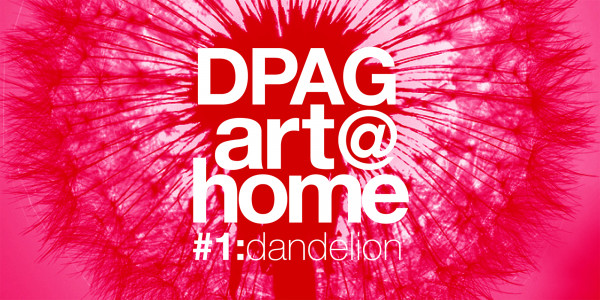
ARTPOST #1
Weekly Update
7 April 2020
Kia ora dear friends of Dunedin Public Art Gallery! We are wanting to stay connected during these extraordinary times - so here is something old (stands for continuity); something new (shows optimism for the future); something borrowed (symbolises borrowed happiness); and something to do...

something old
continuity – a favourite artwork
Gallery Director, Cam McCracken, writes about the much loved Otago Peninsula by Colin McCahon...
For almost a decade from the end of the 1930s, Colin McCahon returned to paint one of the Otago Peninsula’s most spectacular views, looking from Peggy’s Hill across Hereweka/Harbour Cone and out towards the tip of the peninsula. Far more than simply a picturesque vista, this landscape bound together the artist’s ideas, experiences and faith – it was a place of depth, power and inspiration. Right now, more than ever, works of art like this hold the power to lift us out of our everyday surroundings and bolster our spirits. Take care, be safe, and keep in touch with our team as we work out new ways to connect you with the collection that we know you love.
This work is part of our current exhibition A Land of Granite: McCahon and Otago - click here to read more about this exhibition.

something new
optimism for the future – a recent acquisition
Miss Crabb Door (2005) by Fiona Connor
In 2019 the Dunedin Public Art Gallery (DPAG) were thrilled to acquire Fiona Connor’s Miss Crabb Door (2005). Adding to the exisiting holdings of Connor’s work, which were aquired following her 12-week residency at the DPAG in 2012, Miss Crabb Door represents an earlier period in Connor’s practice and speaks to her ongoing interest in the power of everyday objects.
Connor’s sculptures, installations and curatorial projects often look to, and replicate, everyday objects and locations. Connor’s works, which are painstakingly crafted, often isolate architectural sites or features to explore ideas of place, form, function and time. Miss Crabb Door is an exact replica of the front door to the Miss Crabb clothing store on Ponsonby Road in Auckland, which has since closed. Miss Crabb Door acts as a marker of that business and its location at that time – it is a carrier of this specific history.
Doors have often appeared in Connor’s work, as markers of a particular place and time. Her exhibition Closed Down Clubs (2018) for example, presented a suite of replicated doors from a series of clubs that were no longer operational across Los Angeles, California, where Connor is now based. Removed from their utilitarian function, these replicas carry the minutiae of use, from dents and scratches to weathering and paint fragments, to the open/closed sign that hangs in the window of Miss Crabb Door.
As one of the DPAG’s most recent acquisitions, Miss Crabb Door made its gallery debut in Additions + Alterations. This exhibition, which opened in February 2020, presents eight works from the Dunedin Public Art Gallery’s contemporary collection, alongside new work by Wellington-based artist Emily Hartley-Skudder. Although the DPAG is presently closed, you can still take a look around this exhibition on our website: https://dunedin.art.museum/exhibitions/present/additions-alterations/
___________________________________

something borrowed
borrowed happiness — from a past DPAG exhibition
The Cubic Structural Evolution Project by Olafur Eliasson [3 May - 3 August 2014]
Remember the LEGO exhibition [aka: The Cubic Structural Evolution Project by Danish artist Olafur Eliasson]. Thousands of you made thousands of creations from thousands of white Lego bricks, including castles, Greek temples, entire city-scapes, the Eiffel Tower, sailing ships, airplanes, Lego-zilla, Lego-gators.... We could borrow from this outpouring of creativity and set up our own structural evolution project at home - what free-form creations / scapes / empires will evolve from our own lego collections over these weeks? Take a look at the past exhibition listing for inspiration or for just a good old nostalgia trip: click here
___________________________________

something to do...
My curves are not crazy
HENRI MATISSE
This is the first in a practical series exploring the techniques of some well-known and not-so-well-known artists, many of whom have work in the Dunedin Public Art Gallery collection.
We realise that at this time, you will have to make do with what you have on hand to emulate the styles of some of the world’s greatest artists, and that in itself could be a challenge, but hope that you will be inspired to continue this good work nonetheless!
Our first artist is the uplifting and joyous Henri Matisse.
Most of Matisse's paintings were in oil paint on canvas, but today we will look at his cut-outs that he made in later life.
To make his cut-outs, Matisse coloured heavy art paper with gouache paint.
- If your children have a paint box at home, it is likely to be gouache. You could experiment with small pieces of cardboard to get the effect you want (you would use up the paint too quickly if you made a large shape).
- Use a medium-sized brush so that you don't have to make too many brush strokes to fill your piece of card. Let the paint dry. You may need to put weights on the edges. Luckily gouache dries very quickly!
- Get out the scissors, and don't think too hard about the shape – just cut something out of your paper or card.
- Repeat the painting, drying and cutting process as many times as you like.
- Emulate Matisse and pin your cut-out shapes to a solid surface (perhaps not the lounge wall!) and move them around until you find a composition you like.
- If you don't have any larger pieces of card or paper at home, take a photo of the composition on your phone and when you can purchase stationery materials, you could reproduce the composition and glue it in place!
So, take some inspiration from Matisse: pick up a paintbrush and, later, those scissors and experiment!
Here are some digital resources if you would like to learn more about Matisse’s cut-outs:
http://www.henri-matisse.net/cut_outs.html
https://www.youtube.com/watch?v=rLgSd8ka0Gs
___________________________________

If your kids are stuck for something to do, these activities could be just the ticket!
In the first DPAGart@home #1dandelion video, Gallery Educator, Jen Boland, finds inspiration in the garden and demonstrates some practical and fun ways for children to make their own painting of a dandelion – or other plant or object they find themselves! In #2 ice flowers, Jen creates an ice flower wreath to hang in the garden - giving simple instructions for children to make their own version of this fun and unusual object.
Click on the highlighted titles to view the video clips - enjoy - and there will be more! - keep an eye on our facebook page and visit our Art at Home page on our web site.